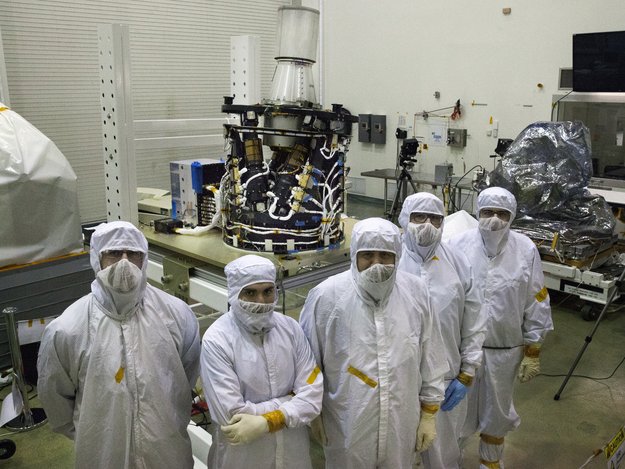On Saturday, SpaceX is expected to make history by launching its first Falcon 9 rocket from historic launch pad 39A at Kennedy Space Center in Cape Canaveral, Florida.
The pad was originally used during NASA's Apollo era in the 1960s but was revamped to serve the space shuttle in the 1970s.
"Some of humanity's greatest adventures in orbit began at Launch Complex 39A," NASA said in a statement. "Astronauts lifted off from this pad six times between 1969 and 1972 to walk upon lunar soil."
On Saturday, 39A will feel the flames of a rocket that represents a new generation of American spaceflight — one marked by private ambition and public partnerships — for the first time.

A Falcon 9 rocket landing on a drone ship in the Pacific Ocean in January 2017.
IMAGE: SPACEX
If all goes according to plan, the Falcon 9 will launch an uncrewed Dragon cargo ship loaded down with astronaut supplies and experiments on its way to the International Space Station at 10:01 a.m. ET. The launch is under a contract with NASA.
But that's not all.
Elon Musk's private spaceflight company will also attempt to land the first stage of the Falcon 9 rocket back on land at Cape Canaveral, a feat they have pulled off twice before. This one will occur during daylight, which will make for a unique spectacle.
You can watch the history-making launch and landing in the window below:
SpaceX usually attempts to land its rockets on drone ships in either the Atlantic or Pacific oceans, far from shore. So far, the company has managed five of those drone ship landings.
While these rocket landings look amazing, they're also out to serve an important purpose.
SpaceX is testing the feasibility of reusing rocket stages instead of building new hardware for every launch. Traditionally, rocket stages are simply discarded in space after serving their purpose, but by reusing them, it could greatly reduce the cost of launching objects to orbit.

A Dragon capsule attached to the International Space Station.
IMAGE: NASA
If this launch is successful, it will be SpaceX's first from Cape Canaveral since one of the company's Falcon 9 rockets exploded during fueling before what should have been a routine test in September.
That explosion occurred at a different one of SpaceX's launch pads, severely damaging it.
Assuming the Dragon takes flight on time, it should reach the Space Station by around Monday.
----
Update: 15.45 MEZ
.
Start-LIVE-Frams:



...
Update: 16.08 MEZ






Quelle: NASA
-
Update: 19.02.2017 / 10.30 MEZ
SpaceX Falcon 9 launch scrubbed for today, rescheduled for Sunday
Take off is scheduled for Sunday at 9:38AM ET
Update:


























Quelle: NASA
-
Update: 20.02.2017
.
Get a drone’s-eye view of SpaceX’s Falcon 9 rocket landing – and much, much more

SpaceX’s first-ever commercial rocket launch from NASA’s Kennedy Space Center was picture-perfect, but the landing was arguably even more photogenic – or should we say “dronogenic”?
The company’s Falcon 9 rocket quickly rose into the clouds over Launch Pad 39A, the Florida takeoff point for Apollo moon missions and space shuttle flights. Within just a few minutes, SpaceX’s robotic Dragon capsule separated from the rocket and headed toward the International Space Station for a cargo delivery.
Meanwhile, a camera-equipped drone captured a thrilling view of the Falcon 9’s first-stage booster descending through the clouds, firing its engines and touching down on SpaceX’s Landing Zone 1, on the Florida coast not far from where its flight began:
SpaceX’s billionaire founder, Elon Musk, posted a zoomed-in view to Instagram.
This was the third time SpaceX brought down a booster successfully at Landing Zone 1. The other touchdowns took place in December 2015 and July 2016. SpaceX has also successfully landed Falcon 9 first stages on a seagoing platform five times.
The point of the exercise is to reuse the boosters and drive down the cost of space launches accordingly. SpaceX President Gwynne Shotwell has estimated that such reusability could reduce the price of a Falcon 9 launch by 30 percent.
SpaceX is getting a refurbished booster ready for the first such re-launch, which is due to put a European-built telecommunications satellite into orbit.
“We should fly a flight-proven booster this March, here, for the SES-10 mission,” Shotwell told reporters at Launch Complex 39A last week. “Out of this pad. Very exciting.”
Check out these very exciting images from today’s launch and landing, gleaned from SpaceX’s Flickr photostream:




...






